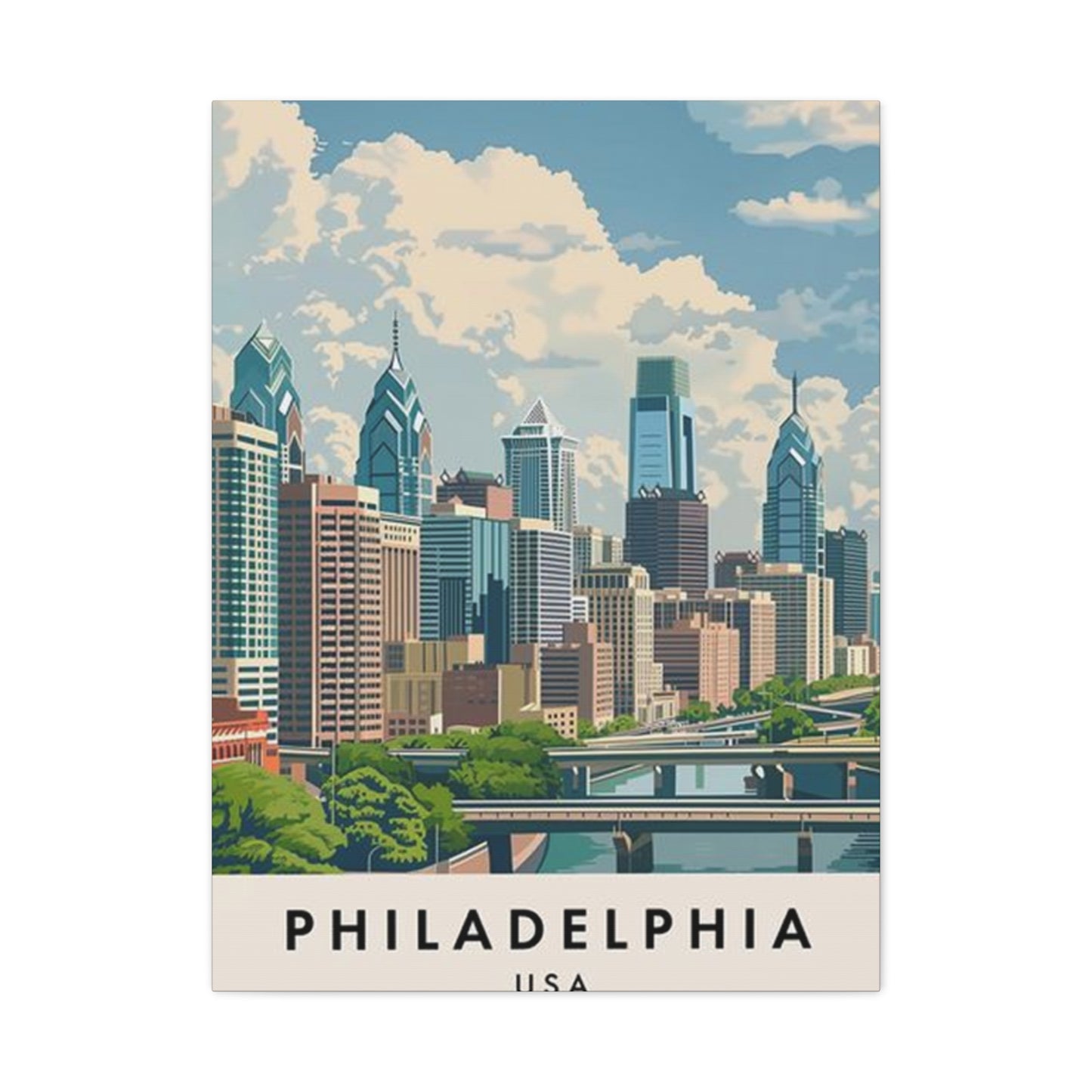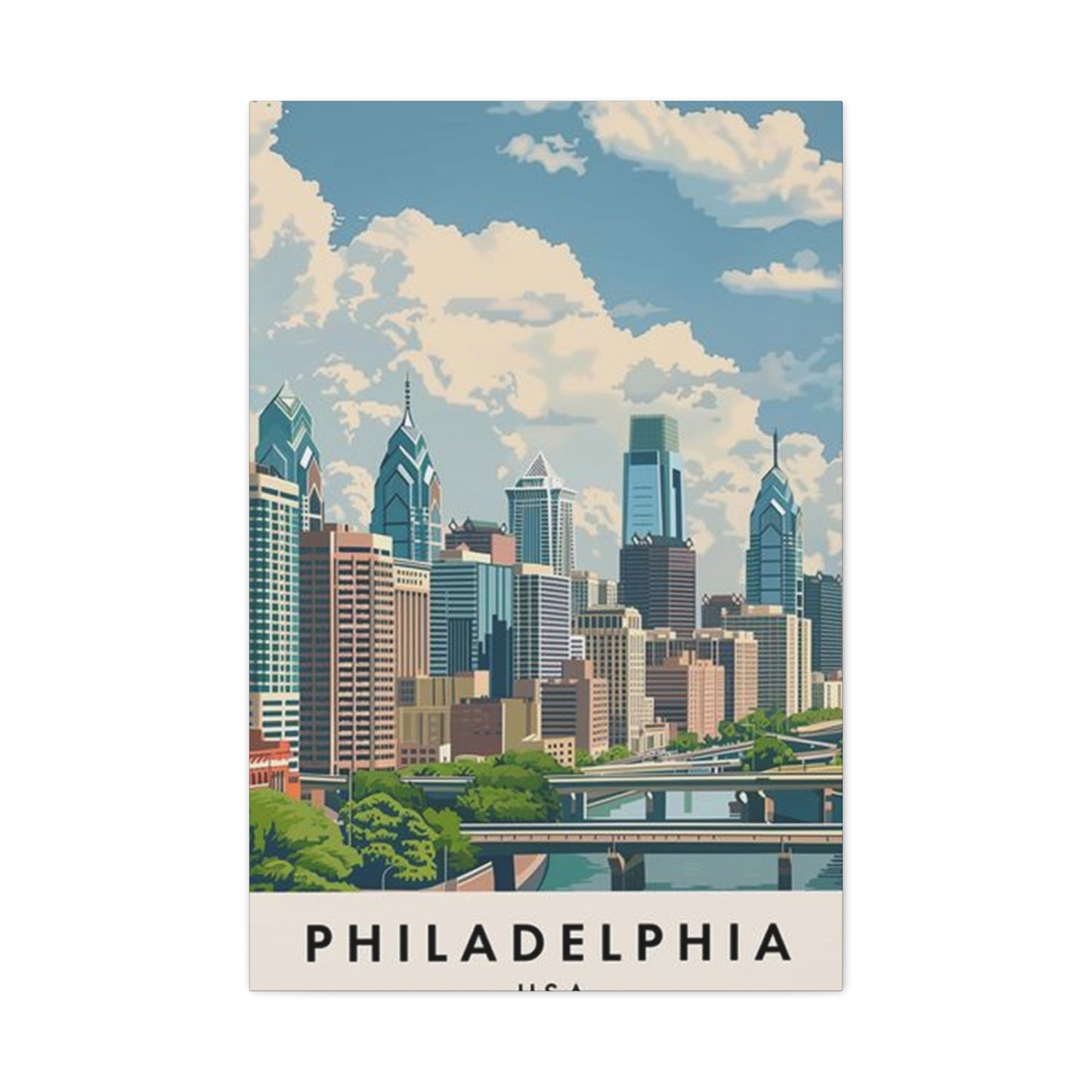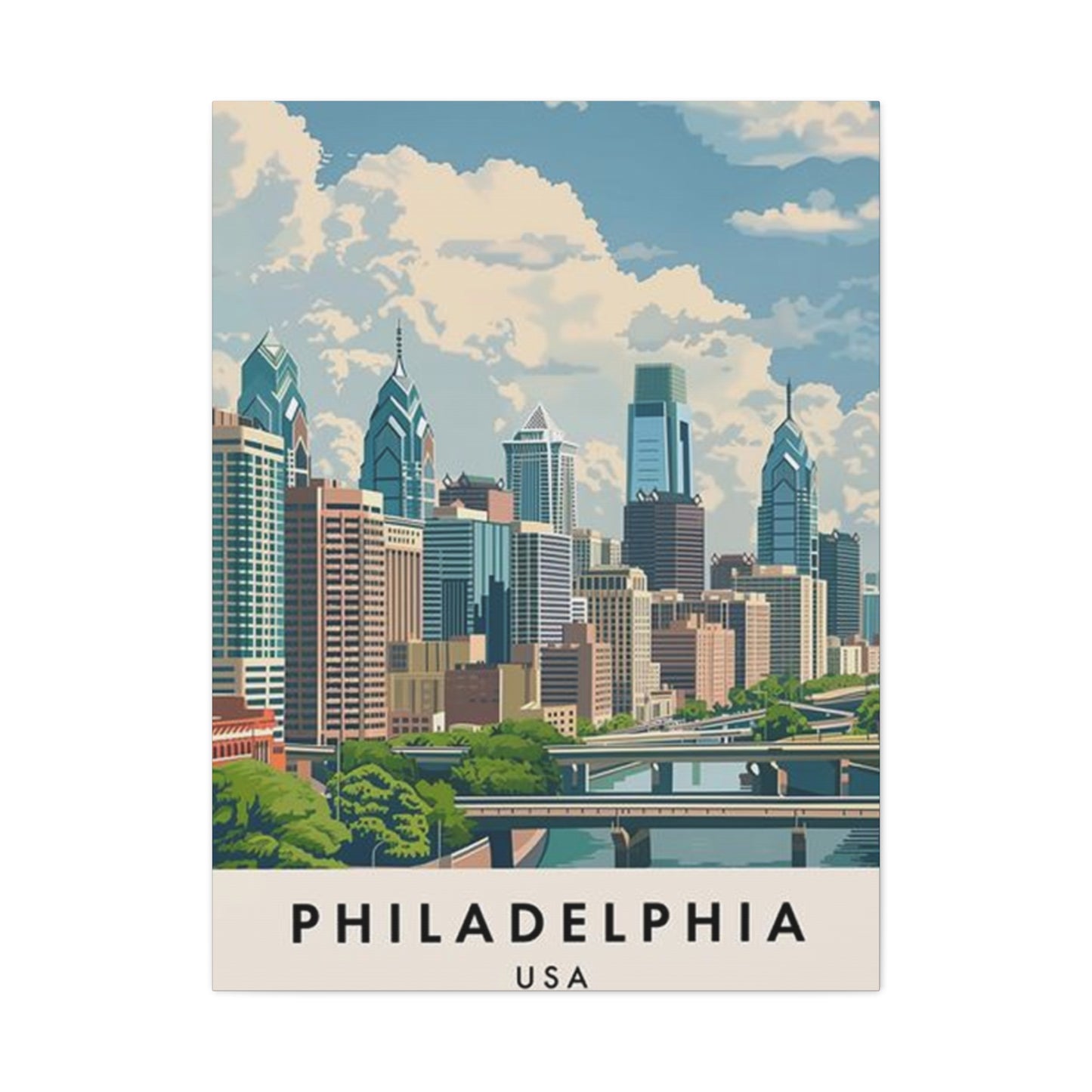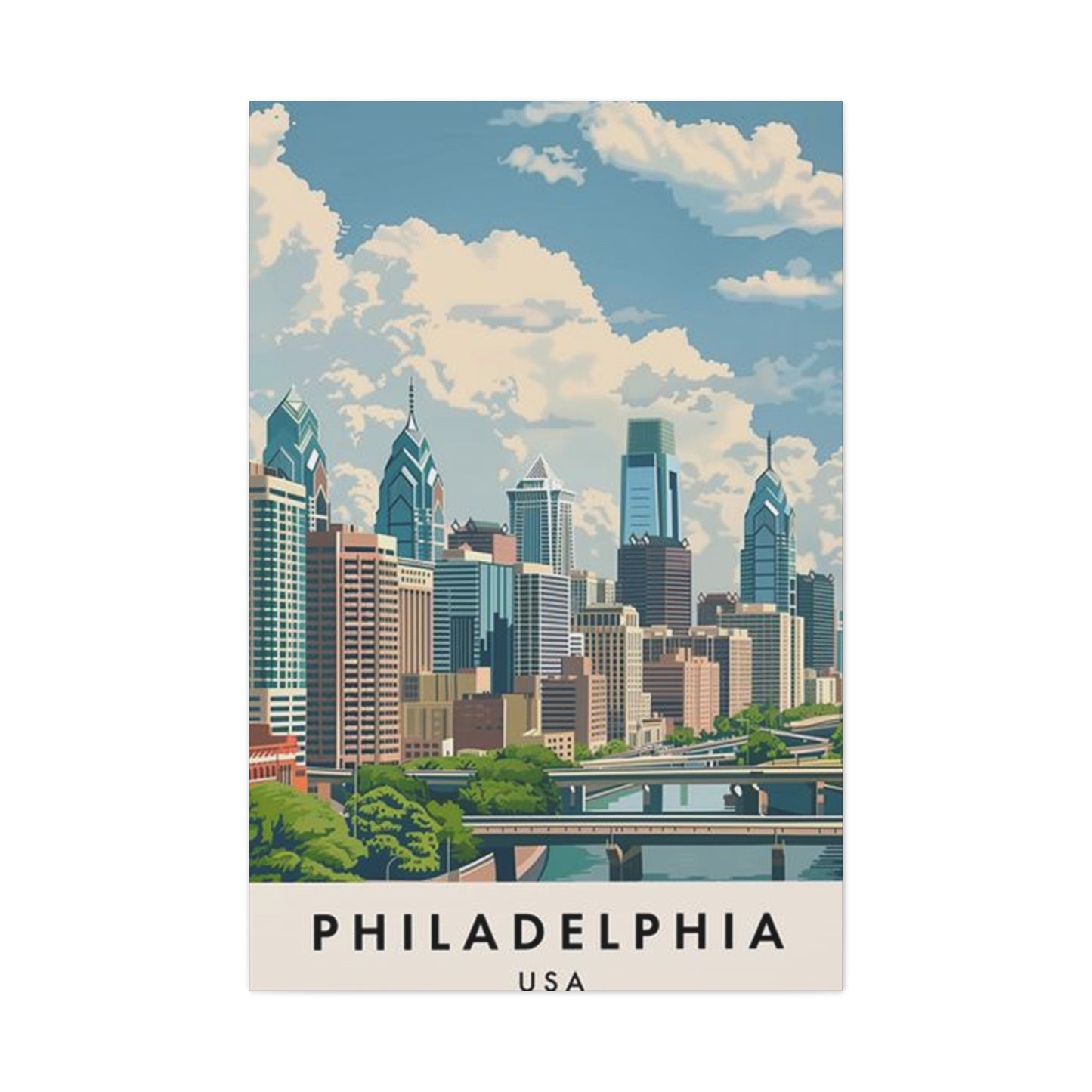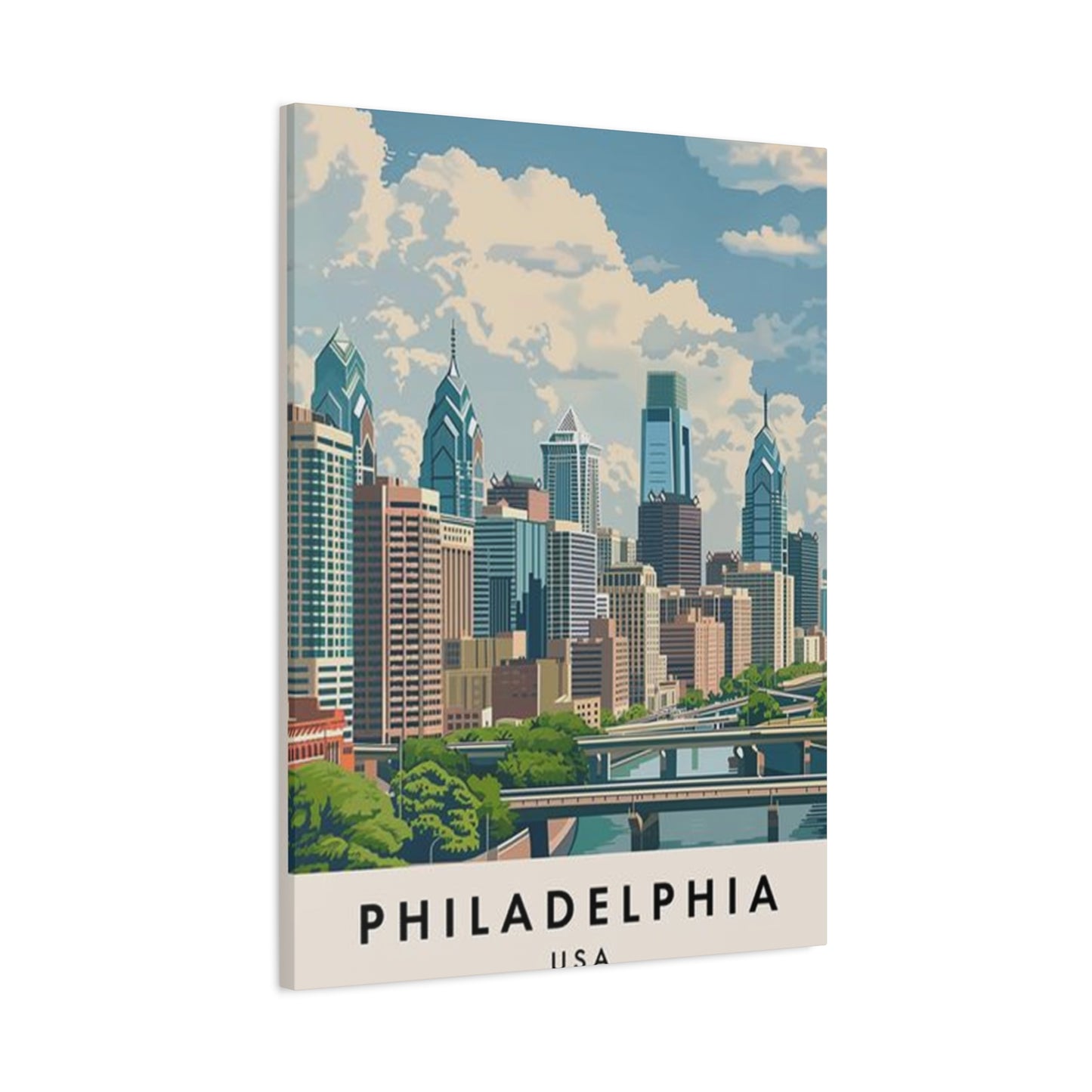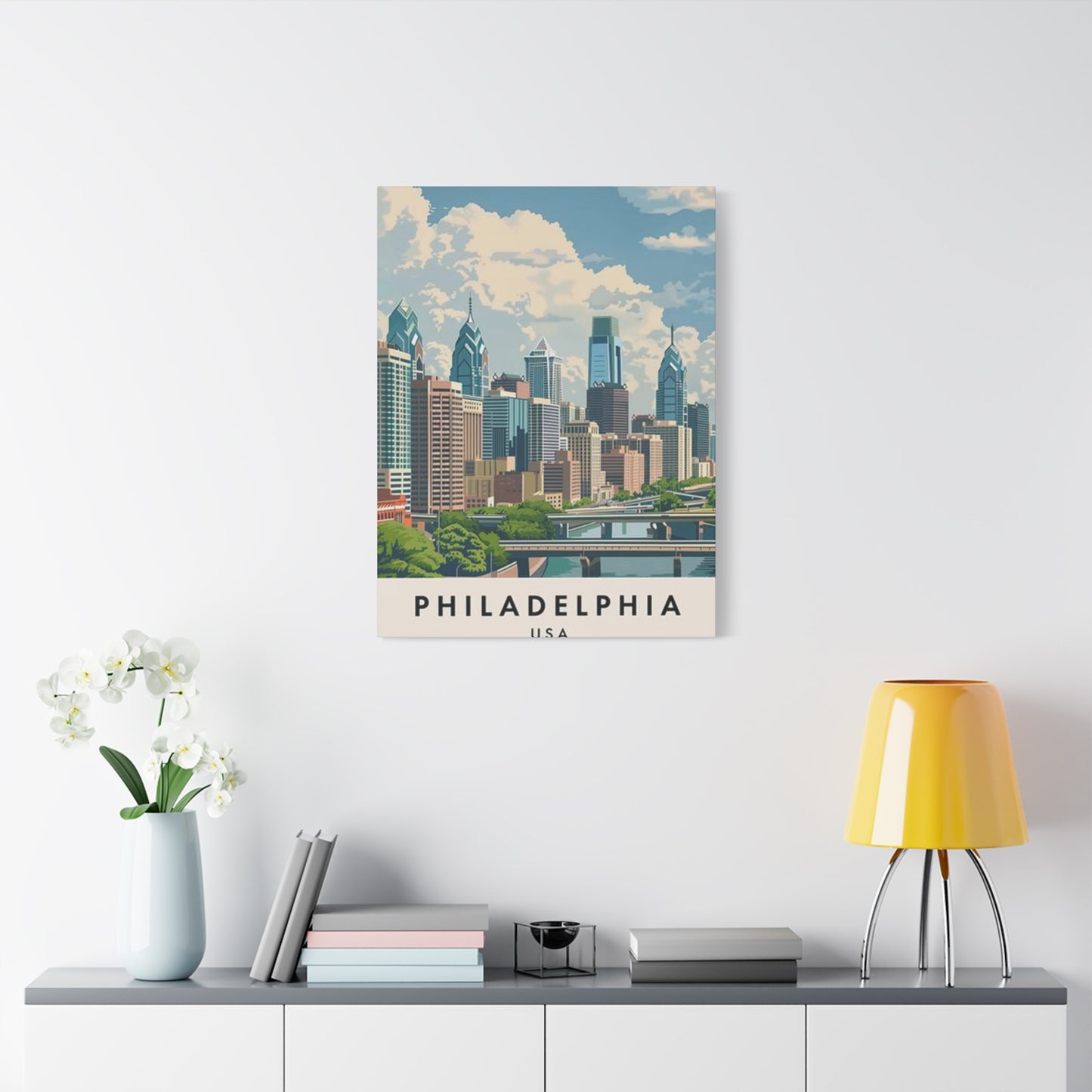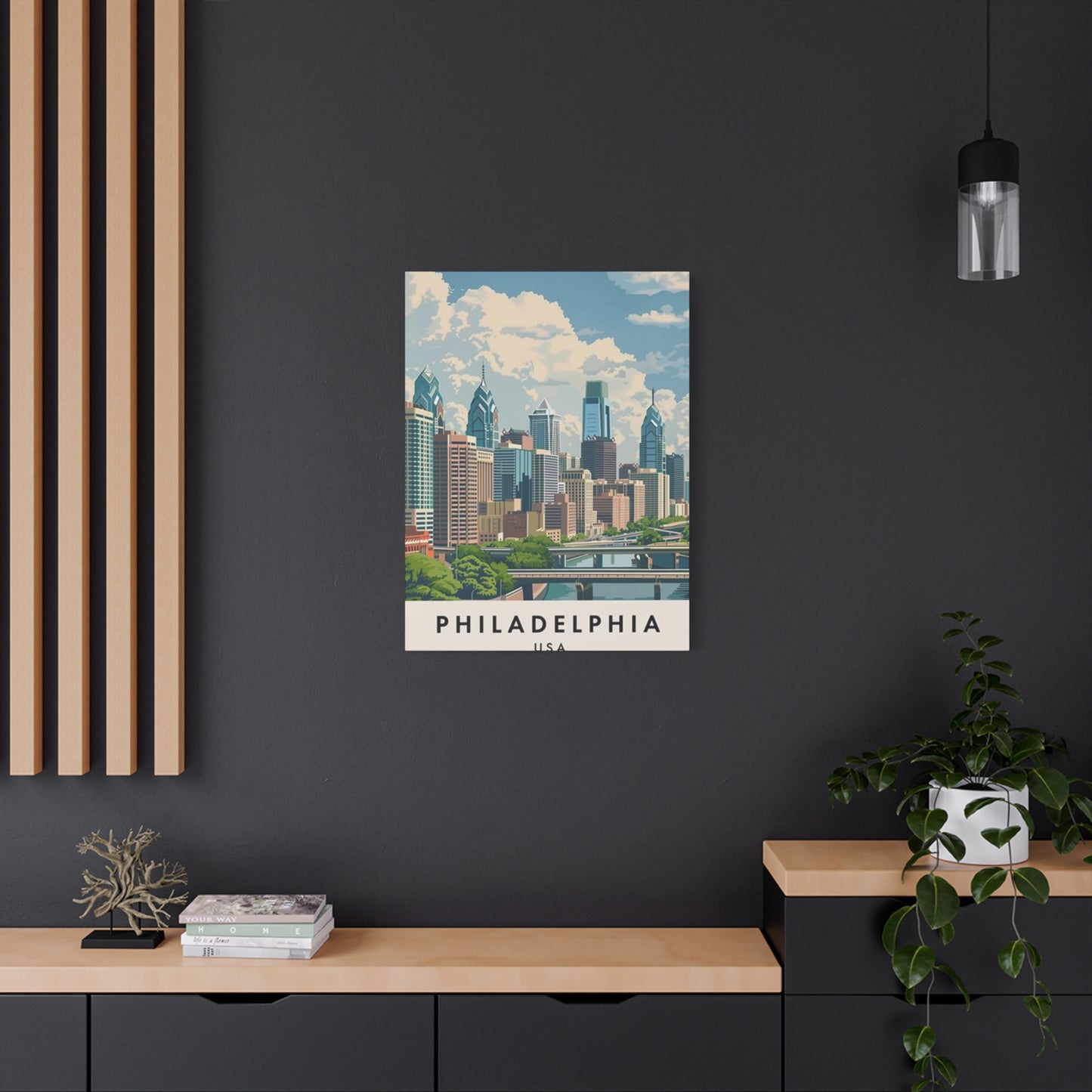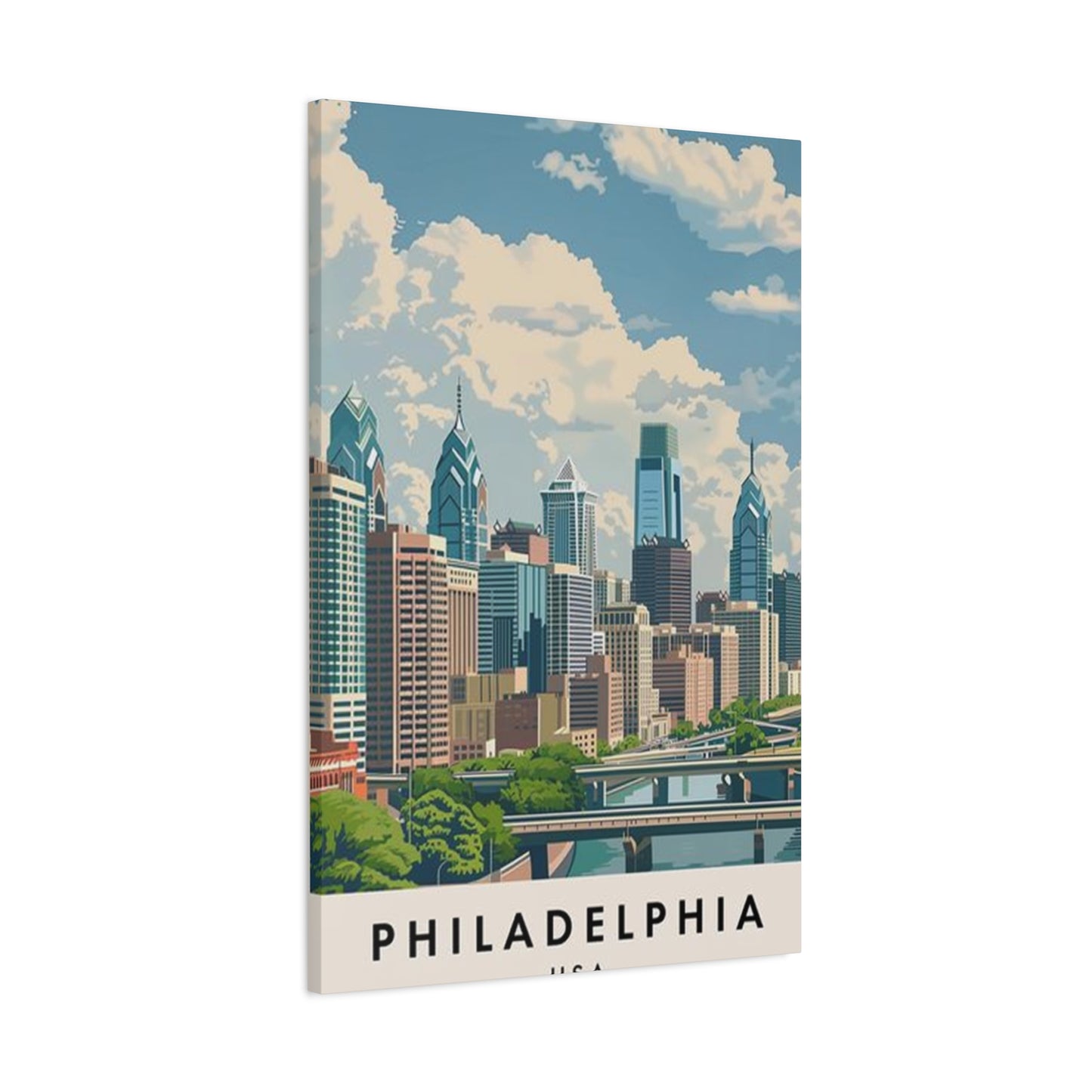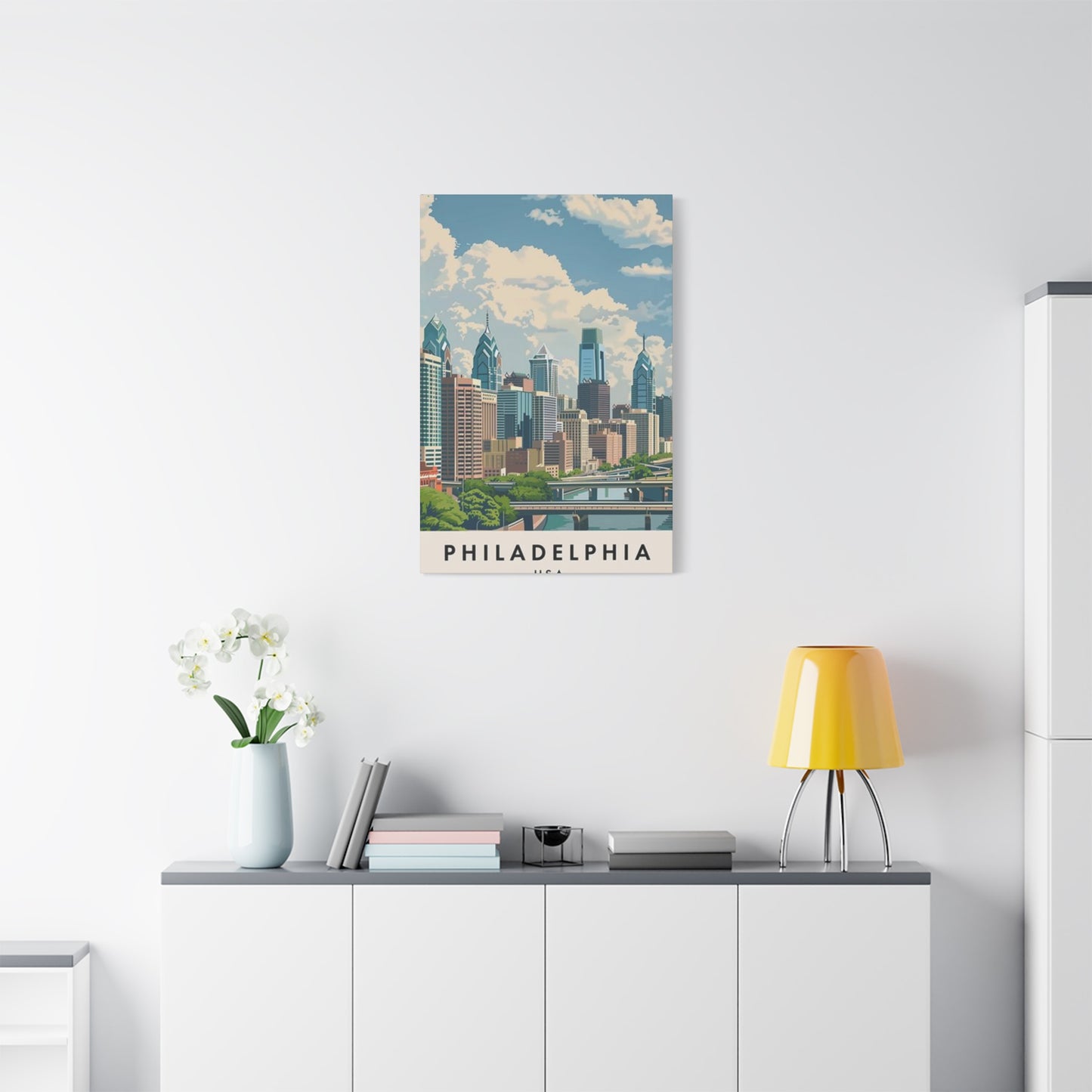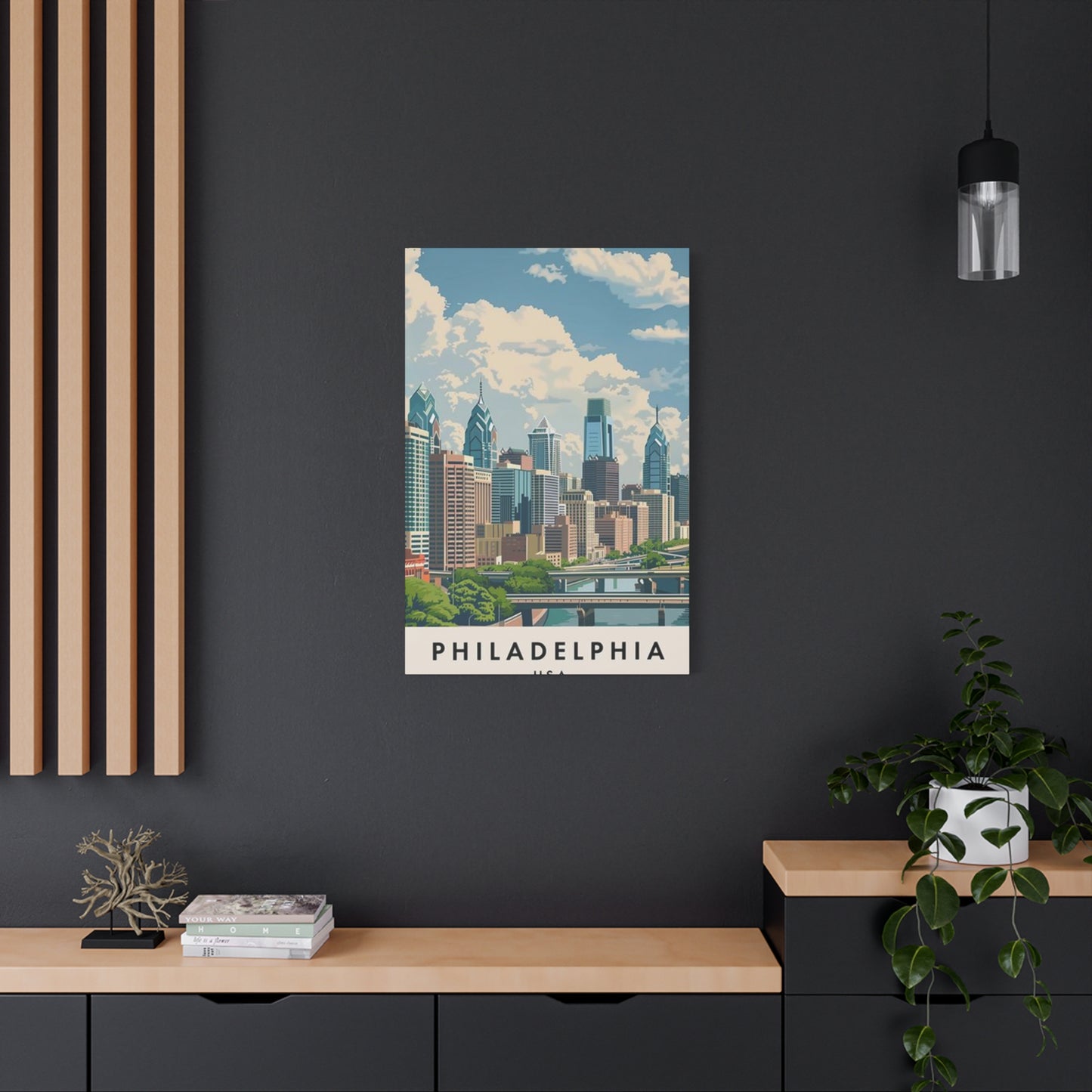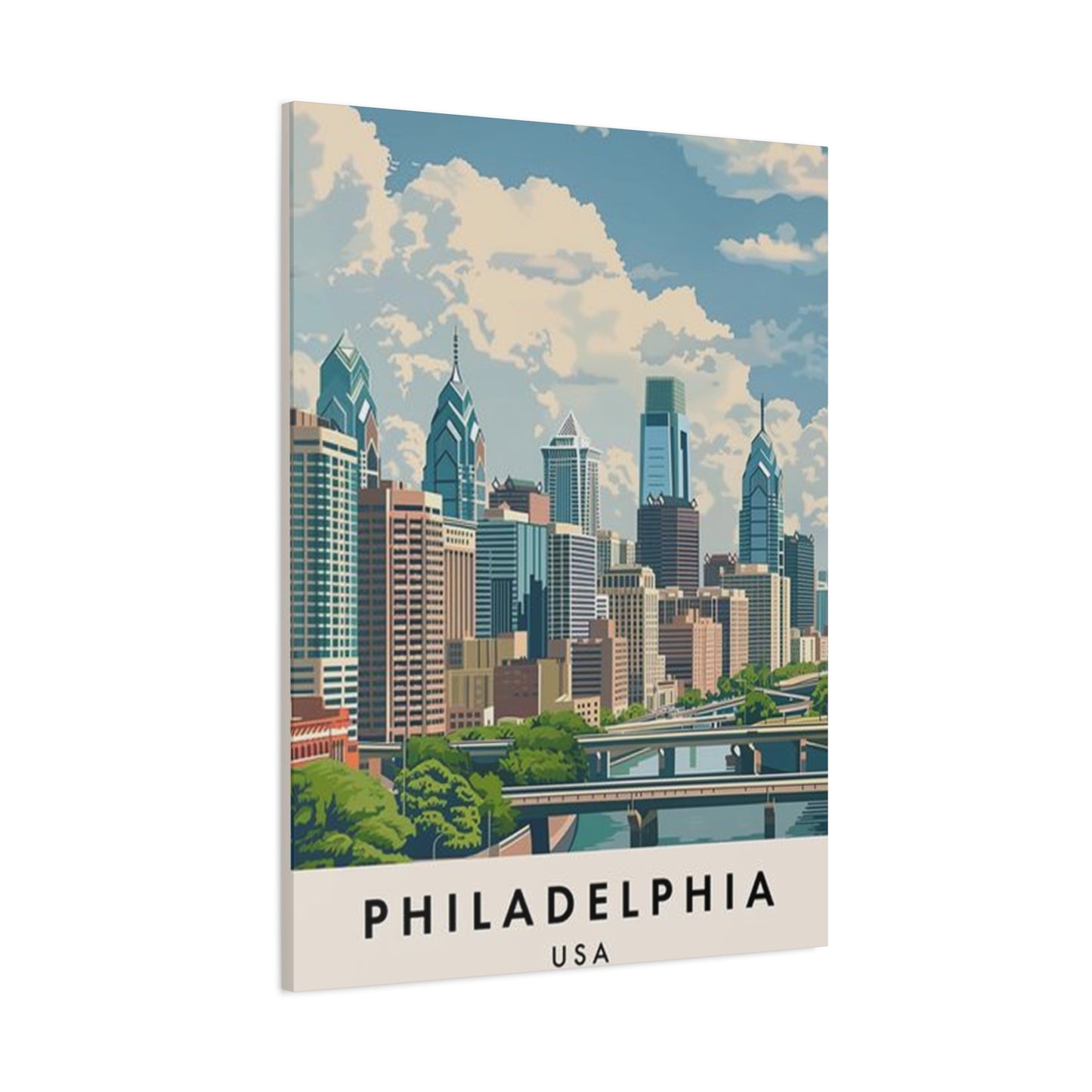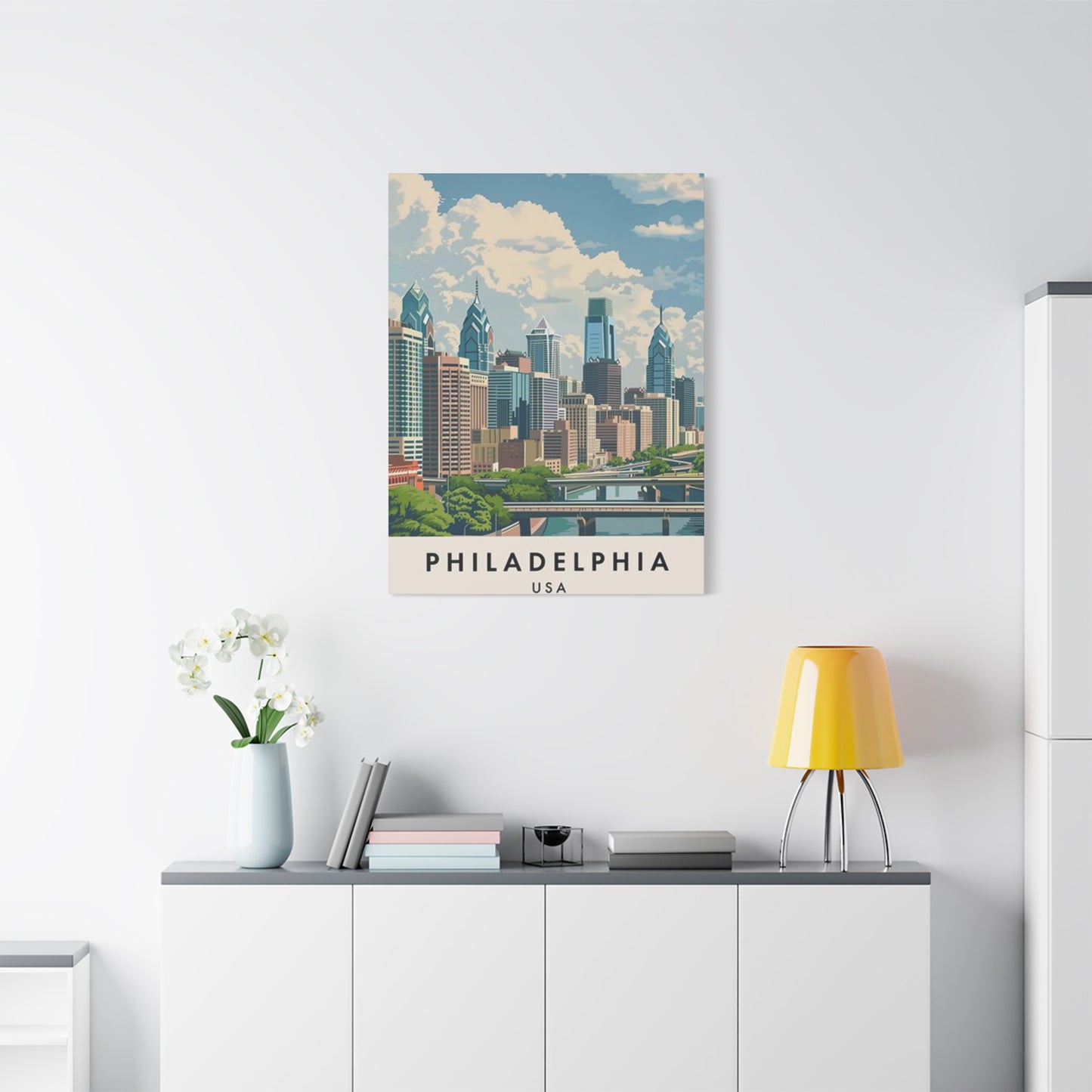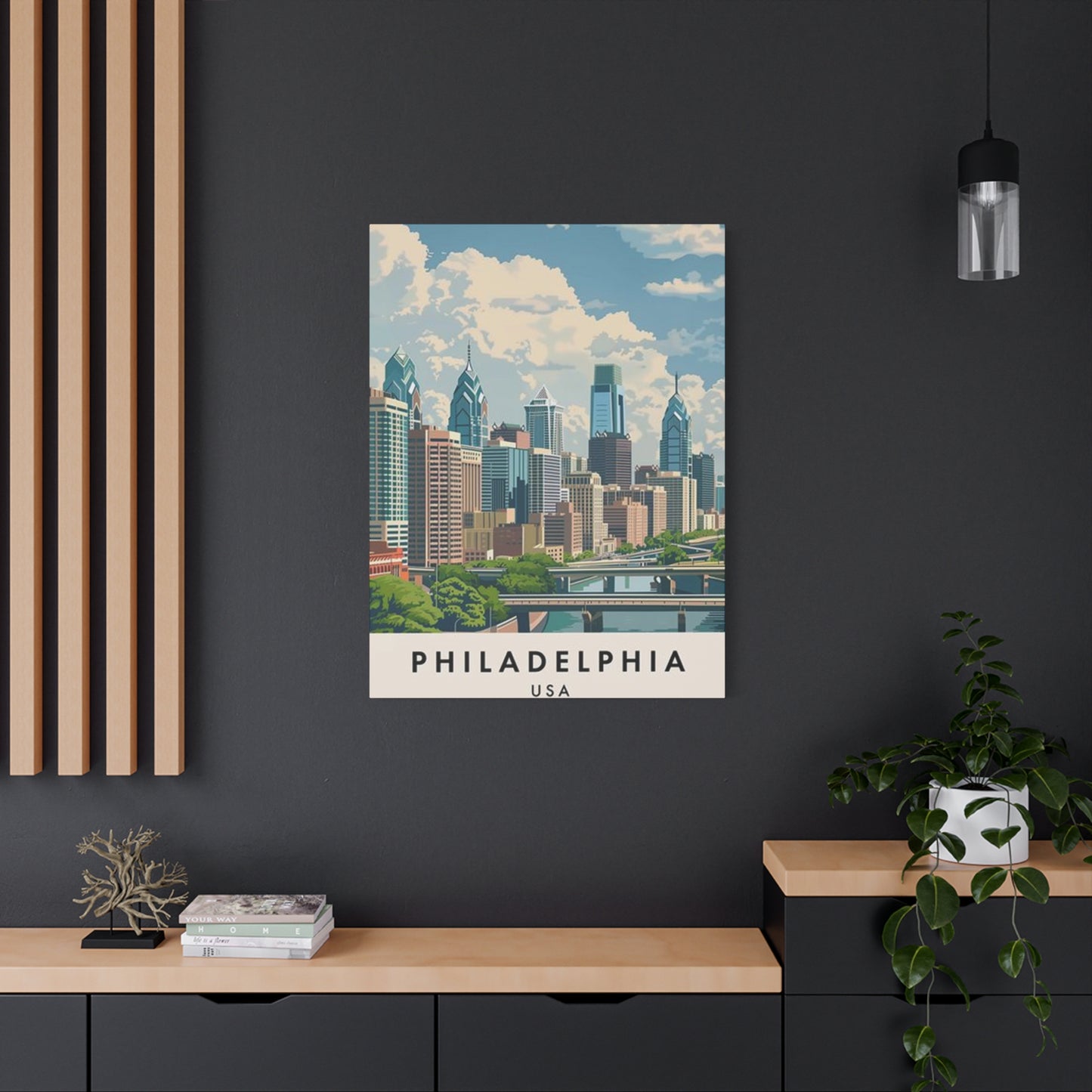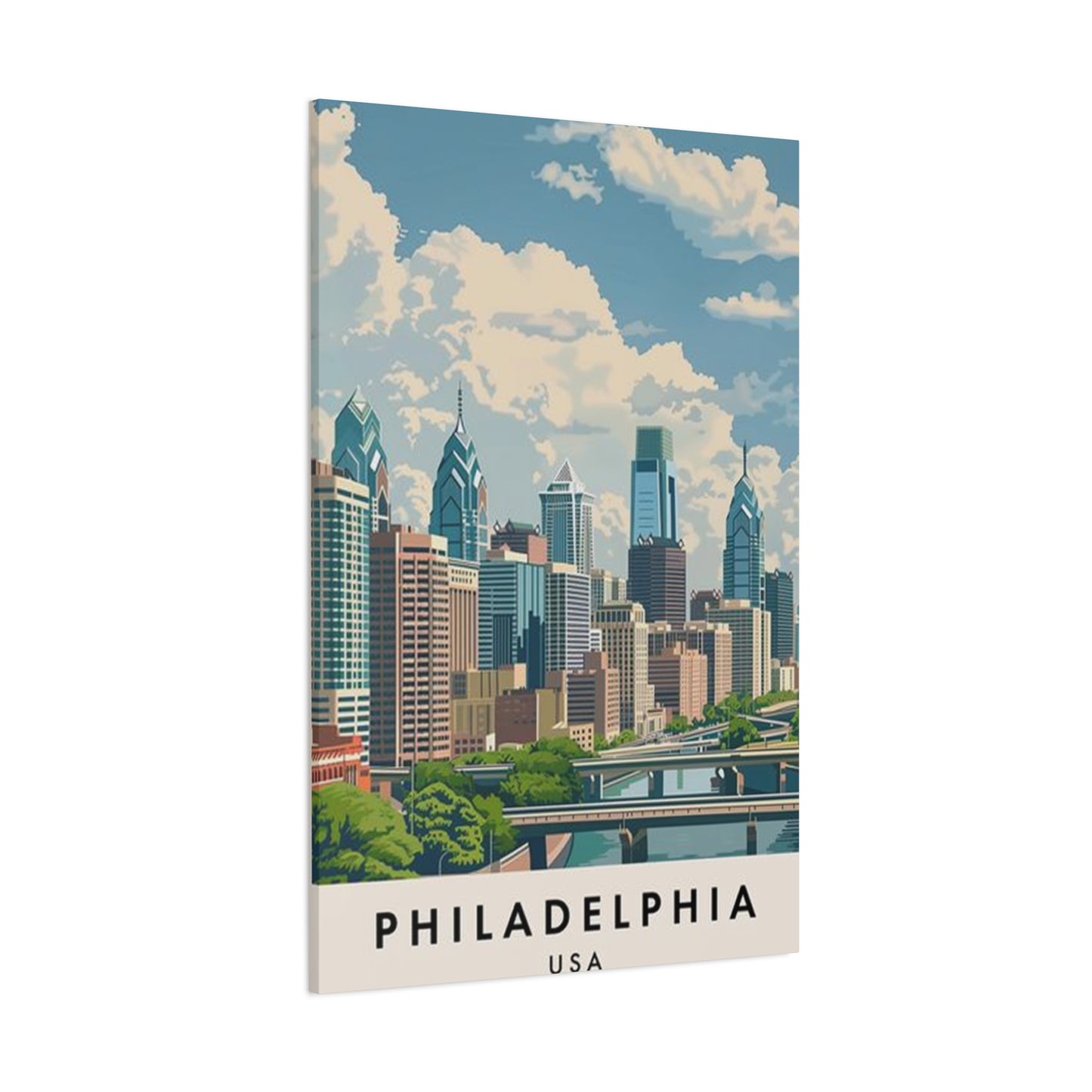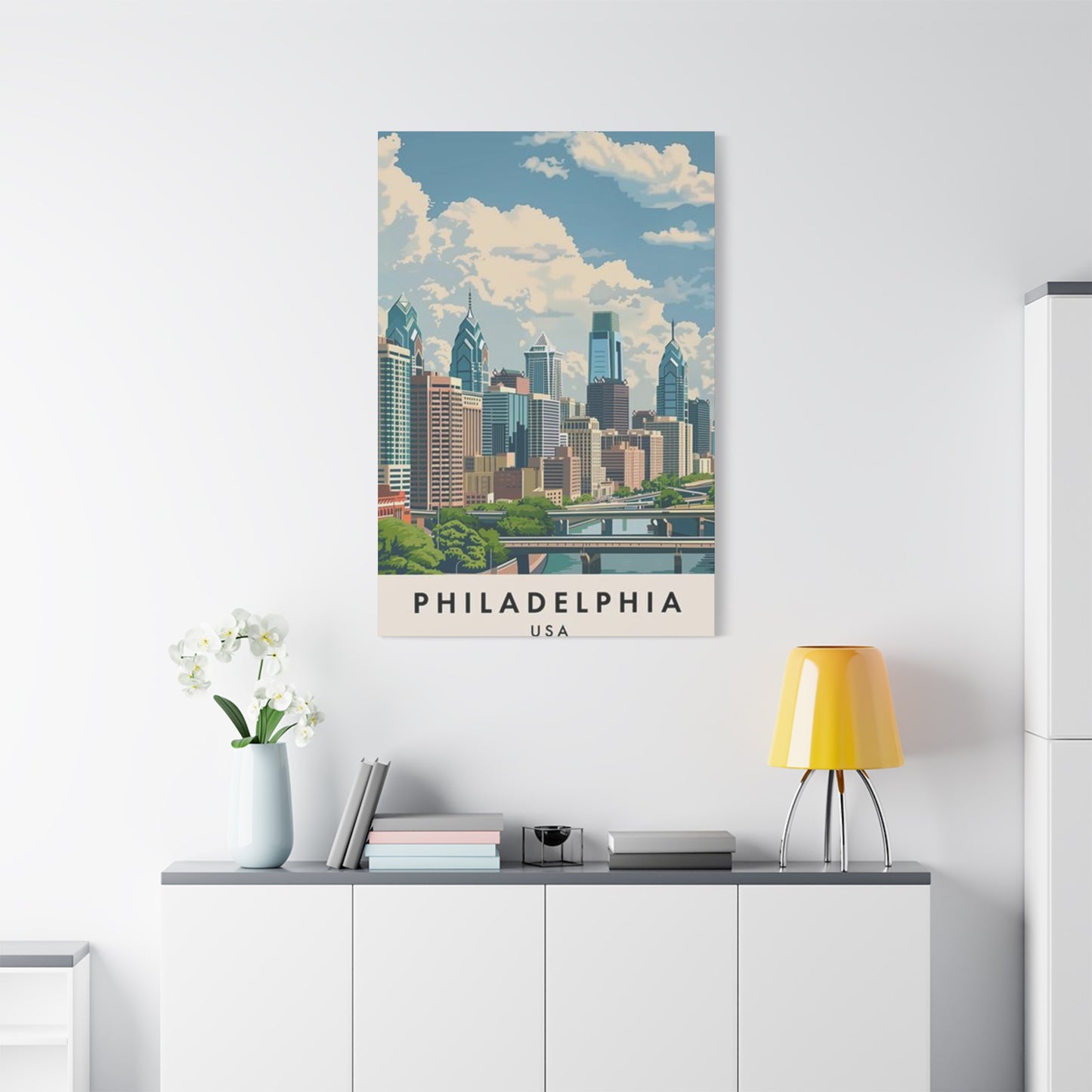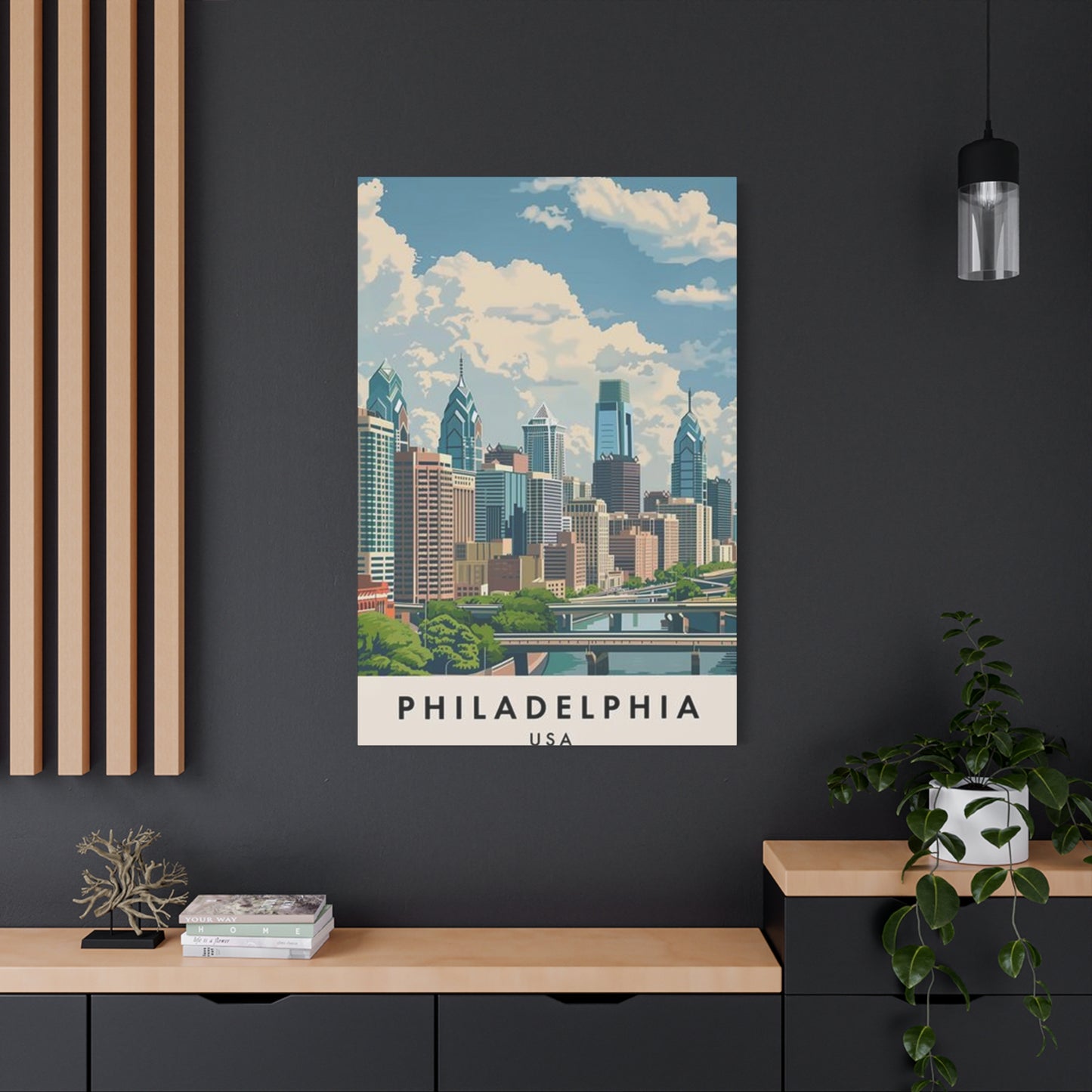Bright Philadelphia Wall Art: Elevating Your Space with Sunny City Scenes
The City of Brotherly Love presents countless opportunities for artistic inspiration, particularly when bathed in golden sunlight that transforms ordinary street corners into extraordinary visual narratives. Philadelphia wall art featuring sunny day scenes has emerged as a powerful tool for interior design, offering homeowners and businesses alike the chance to infuse their spaces with the vibrant energy and cultural richness that defines this historic American city. From the gleaming towers of Center City to the tree-lined neighborhoods of Rittenhouse Square, sunny Philadelphia artwork captures the essence of urban life at its most appealing moments.
The artistic representation of Philadelphia under bright, clear skies serves multiple purposes beyond mere decoration. These pieces function as windows into the soul of a city that has weathered centuries of change while maintaining its distinctive character and charm. When natural light streams through windows and illuminates these carefully chosen artworks, the effect creates an immersive experience that transports viewers directly into the heart of Pennsylvania's most beloved metropolis.
Contemporary interior design increasingly emphasizes the psychological impact of visual elements within living and working spaces. Philadelphia artwork featuring sunny day scenes taps into this understanding, leveraging the inherent mood-boosting properties of bright imagery to create environments that promote positivity, creativity, and emotional well-being. The interplay between authentic Philadelphia architecture, natural lighting conditions, and artistic interpretation results in wall art that serves as both aesthetic enhancement and therapeutic intervention.
The versatility of sunny Philadelphia wall art extends across numerous design styles and spatial configurations. Whether adorning the walls of a minimalist loft in Northern Liberties or complementing traditional furnishings in a Main Line estate, these pieces adapt to their surroundings while maintaining their core appeal. The key lies in understanding how different artistic approaches to Philadelphia's sunny landscapes can serve various decorative and emotional needs within residential and commercial settings.
Celebrating Philadelphia's Iconic Skyline on Sunny Days
Philadelphia's skyline represents one of America's most recognizable urban silhouettes, and when captured during peak sunlight hours, these architectural marvels take on an almost ethereal quality that speaks to both the city's historical significance and its modern aspirations. The interplay between historic structures like Independence Hall and contemporary towers creates a visual narrative that spans centuries, offering viewers a comprehensive glimpse into Philadelphia's evolutionary journey from colonial settlement to major metropolitan center.
The artistic celebration of Philadelphia's skyline during sunny conditions requires careful attention to light dynamics, shadow patterns, and atmospheric conditions that change throughout the day. Morning light casts long shadows across the Delaware River, creating dramatic contrasts that highlight the geometric patterns of office buildings and residential towers. Midday sun eliminates most shadows, producing a more uniform illumination that emphasizes color variations and architectural details often lost in dramatic lighting conditions.
Artists specializing in sunny Philadelphia skyline representations must navigate the technical challenges of capturing both the grandeur of the overall composition and the intricate details that make each building unique. The reflective surfaces of modern skyscrapers interact with sunlight in complex ways, creating mirror effects that multiply the visual impact of surrounding structures. These reflections often capture glimpses of older buildings, creating layered compositions that speak to Philadelphia's architectural diversity.
The emotional response to sunny skyline artwork varies significantly based on viewing perspective and personal connection to the city. Residents who commute daily through Center City may experience nostalgia and pride when viewing these pieces, while visitors might feel inspired by the energy and possibility that urban skylines traditionally represent. The psychological impact intensifies when natural lighting conditions in the viewing space mirror those depicted in the artwork.
Color temperature plays a crucial role in skyline artwork authenticity and emotional impact. Philadelphia's unique atmospheric conditions, influenced by its proximity to both the Atlantic Ocean and the Appalachian Mountains, create distinctive lighting qualities that experienced artists learn to recognize and reproduce. The warm golden tones of late afternoon sun reflecting off glass and steel surfaces produce color palettes that feel specifically Philadelphia-based rather than generically urban.
The technical execution of skyline artwork requires understanding architectural proportions and spatial relationships that define Philadelphia's unique urban geography. The positioning of City Hall's distinctive tower relative to surrounding modern structures creates compositional opportunities that artists exploit to create balanced, harmonious designs. The inclusion of natural elements like the Schuylkill River and Fairmount Park adds organic curves that soften the geometric severity of architectural subjects.
Market demand for Philadelphia skyline artwork has grown considerably as both residents and expatriates seek to maintain visual connections to the city. Corporate clients frequently commission large-scale pieces for office spaces, while residential customers prefer more intimate interpretations suitable for living rooms and bedrooms. The scalability of skyline subjects makes them particularly versatile for various space requirements and budget considerations.
How Bright Philly Wall Art Boosts Your Mood
The psychological impact of bright, sunlit imagery on human mood and mental well-being has been extensively documented through scientific research, with Philadelphia wall art serving as an excellent case study for these principles in action. Exposure to bright, cheerful imagery triggers neurochemical responses similar to those experienced during actual sunny weather, including increased serotonin production and enhanced cognitive function. Philadelphia's distinctive architectural character and cultural vibrancy, when captured in sunny conditions, amplifies these positive effects.
The connection between visual stimuli and emotional state operates through complex neurological pathways that evolved to help humans navigate seasonal changes and environmental conditions. Bright Philadelphia artwork essentially tricks the brain into experiencing some of the same benefits associated with spending time outdoors on pleasant days. This phenomenon proves particularly valuable for individuals living in spaces with limited natural light or those dealing with seasonal mood variations.
Color psychology plays a fundamental role in how Philadelphia wall art affects viewer emotions. The warm yellows, oranges, and golden tones commonly found in sunny day photography and artwork stimulate areas of the brain associated with happiness, energy, and optimism. When these colors appear in familiar Philadelphia contexts, the emotional impact combines with personal memories and associations to create particularly powerful mood enhancement effects.
The cultural significance embedded within Philadelphia imagery adds layers of meaning that enhance the mood-boosting properties of bright artwork. Viewers with personal connections to the city experience additional emotional benefits through nostalgia, pride, and sense of belonging. Even individuals without direct Philadelphia experience often respond positively to the city's reputation for resilience, creativity, and community spirit, qualities that sunny day artwork naturally emphasizes.
Research in environmental psychology suggests that artwork depicting outdoor scenes can reduce stress hormones and promote relaxation responses similar to those experienced in natural settings. Philadelphia's abundant green spaces, from Rittenhouse Square to Fairmount Park, provide artists with numerous opportunities to combine urban architectural elements with natural beauty, creating compositions that maximize these therapeutic benefits.
The timing and duration of exposure to bright Philadelphia artwork influences its mood-enhancing effectiveness. Strategic placement in areas where individuals spend significant time, such as home offices or bedrooms, allows for repeated exposure that can gradually improve overall emotional well-being. The cumulative effect of daily interactions with positive imagery creates lasting changes in mental outlook and stress response patterns.
Seasonal variations in natural lighting conditions make bright Philadelphia artwork particularly valuable during winter months when reduced daylight exposure can negatively impact mood and energy levels. The consistent availability of sunny imagery provides a reliable source of visual stimulation that helps maintain emotional equilibrium regardless of external weather conditions. This stability proves especially important for individuals sensitive to seasonal changes.
The social aspects of sharing living spaces decorated with bright Philadelphia artwork extend the mood-boosting benefits beyond individual viewers. Guests and family members exposed to these positive visual elements often report feeling more comfortable and energetic in such environments. The artwork serves as conversation starters that can lead to positive social interactions and shared experiences that further enhance emotional well-being.
Using Sunlight Themes to Brighten Urban Decor
The integration of sunlight themes into urban interior design represents a sophisticated approach to creating spaces that feel connected to the natural world while celebrating the energy and excitement of city living. Philadelphia, with its rich architectural heritage and diverse neighborhoods, provides ideal subject matter for artwork that captures the magical interplay between natural illumination and human-built environments. The strategic use of sunlight-themed Philadelphia pieces can transform sterile urban spaces into warm, inviting environments that reflect the best qualities of both natural and metropolitan settings.
Sunlight themes in urban decor operate on multiple sensory and psychological levels, creating visual warmth that compensates for the potential coldness of concrete, steel, and glass materials commonly found in city environments. The golden hour lighting that frequently appears in Philadelphia artwork adds organic warmth to spaces that might otherwise feel harsh or unwelcoming. This transformation proves particularly valuable in loft apartments, office buildings, and commercial spaces where industrial materials dominate the aesthetic landscape.
The technical aspects of incorporating sunlight themes require careful consideration of existing lighting conditions within the decorated space. Natural light entering through windows interacts with artwork in complex ways, sometimes enhancing the sunny themes and occasionally creating competing visual elements that diminish the desired effect. Successful implementation requires understanding how different times of day affect both natural and artificial lighting conditions within the space.
Color coordination becomes crucial when implementing sunlight themes, as the warm tones typical of sunny Philadelphia artwork must harmonize with existing furnishings, wall colors, and decorative elements. The golden yellows, warm oranges, and soft browns found in sunlit urban photography work particularly well with neutral color schemes, earth tones, and natural materials like wood and stone. These combinations create cohesive design narratives that feel intentional rather than accidental.
The scale and placement of sunlight-themed artwork significantly impacts its effectiveness in brightening urban decor. Large-scale pieces featuring expansive Philadelphia vistas can serve as focal points that draw attention and create visual interest, while smaller works might be grouped to create gallery walls that build cumulative impact. The positioning relative to natural light sources affects how the artwork appears throughout the day, with some placements creating dynamic visual changes as lighting conditions shift.
Layering different artistic interpretations of Philadelphia's sunny scenes creates depth and visual interest that single pieces cannot achieve. Combining photographic prints with painted interpretations, or mixing contemporary artwork with vintage Philadelphia imagery, creates rich visual narratives that reward extended viewing and contemplation. These layered approaches work particularly well in spaces where people spend significant time, such as living rooms and home offices.
The seasonal relevance of sunlight-themed decor provides year-round benefits that extend beyond mere visual appeal. During winter months when natural sunlight becomes scarce, these artistic elements serve as psychological anchors that maintain connection to brighter, more optimistic times. The consistency of sunny imagery helps regulate mood and energy levels regardless of external weather conditions or seasonal changes.
The cultural authenticity embedded within Philadelphia-specific sunlight themes adds meaning and depth that generic sunny imagery cannot provide. Local viewers recognize specific locations, architectural details, and cultural references that create personal connections and emotional resonance. These authentic elements transform decorative artwork into meaningful expressions of place-based identity and community belonging.
Sunny Day Scenes That Capture Philadelphia's Charm
Philadelphia's inherent charm manifests most clearly during sunny day conditions when natural light reveals the intricate details and warm character that make the city uniquely appealing to residents and visitors alike. The artistic capture of these moments requires understanding what specific elements combine to create Philadelphia's distinctive personality, from the weathered brick facades of Colonial-era buildings to the vibrant street art that adorns contemporary neighborhoods. Sunny day scenes provide optimal conditions for showcasing the textures, colors, and architectural details that define Philadelphia's visual identity.
The charm of sunny Philadelphia scenes often lies in the juxtaposition of historical and contemporary elements within single compositions. Old City's cobblestone streets, when bathed in morning sunlight, create patterns of light and shadow that emphasize the handcrafted quality of 18th-century construction techniques. These same streets might feature modern cafes with outdoor seating, creating visual narratives that speak to Philadelphia's evolution while maintaining its historical character.
Neighborhood diversity provides artists with endless opportunities to capture different facets of Philadelphia's charm under sunny conditions. Rittenhouse Square's tree-lined elegance presents a markedly different aesthetic from the colorful murals and bustling activity of South Street, yet both locations share the warm, welcoming quality that sunny weather brings to urban environments. The artistic challenge lies in identifying and emphasizing the unique characteristics that make each area distinctive while maintaining overall coherence.
The human element plays a crucial role in Philadelphia charm, with sunny day scenes often featuring residents and visitors engaged in activities that reflect the city's cultural values. Outdoor dining, street performances, farmers markets, and community gatherings become more frequent and visible during pleasant weather conditions. These human activities add life and movement to architectural subjects, creating dynamic compositions that feel alive and engaging.
Seasonal timing affects how Philadelphia's charm manifests in sunny day artwork, with spring cherry blossoms, summer festival energy, autumn foliage, and winter snow each providing different opportunities for artistic expression. The consistency of Philadelphia's architectural foundation allows artists to explore how changing natural elements interact with permanent built environments to create evolving narratives of urban charm.
The technical aspects of capturing Philadelphia's sunny day charm require attention to lighting quality, color temperature, and atmospheric conditions that change throughout the day and across seasons. Early morning light often provides the most flattering illumination for architectural subjects, while late afternoon sun creates dramatic shadows that can emphasize texture and form. Understanding these lighting dynamics allows artists to choose optimal conditions for highlighting specific aspects of Philadelphia's character.
Cultural events and seasonal celebrations provide particularly rich opportunities for sunny day Philadelphia artwork, as these occasions bring communities together in public spaces and create memorable visual spectacles. The Mummers Parade, outdoor concerts, street festivals, and holiday celebrations all benefit from sunny weather conditions that encourage participation and create festive atmospheres ideal for artistic documentation.
The emotional resonance of Philadelphia's sunny day charm extends beyond visual appeal to encompass feelings of community, belonging, and civic pride that residents associate with positive experiences in familiar locations. Artwork that successfully captures these emotional qualities creates lasting connections with viewers who recognize not just the physical appearance of depicted locations but also the feelings and memories associated with them.
Mixing Bright City Art with Natural Elements
The successful integration of bright Philadelphia city art with natural elements creates interior design compositions that celebrate both urban sophistication and organic beauty, resulting in spaces that feel balanced, harmonious, and emotionally nurturing. This approach recognizes that humans have inherent needs for both cultural stimulation and natural connection, making the combination particularly effective for creating environments that support well-being and creativity. Philadelphia's abundance of green spaces, from Fairmount Park to pocket parks throughout residential neighborhoods, provides ideal subject matter for artwork that naturally combines urban and natural elements.
The strategic placement of Philadelphia city art alongside living plants, natural materials, and organic textures creates visual dialogues that enhance both elements while avoiding competition for attention. Bright cityscape prints gain added warmth when surrounded by wooden frames, natural fiber textiles, and healthy houseplants that echo the green spaces often featured in urban photography. These combinations create cohesive design narratives that feel intentionally curated rather than accidentally assembled.
Color coordination becomes particularly important when mixing bright city art with natural elements, as the warm tones typical of sunny Philadelphia imagery must complement the greens, browns, and earth tones found in natural materials and living plants. The golden hour lighting commonly featured in urban artwork provides natural bridges to wooden furniture, leather upholstery, and stone accents that might otherwise clash with more vibrant artistic elements.
Scale relationships require careful consideration when combining Philadelphia artwork with natural elements, as oversized prints can overwhelm delicate plants while tiny artworks might disappear among substantial natural materials. The goal involves creating visual balance where each element contributes to the overall composition without dominating or being dominated by surrounding features. This balance often requires experimentation and adjustment as plants grow and natural materials age and develop patina.
Lighting design plays a crucial role in successfully mixing bright city art with natural elements, as both categories of design elements respond differently to various lighting conditions. Philadelphia artwork often looks best under warm, directional lighting that mimics the sunny conditions depicted in the pieces, while plants require specific light qualities for healthy growth. Finding lighting solutions that serve both needs often involves layering different light sources and adjusting their intensity and color temperature throughout the day.
The temporal aspects of combining city art with natural elements add dynamic qualities that static design approaches cannot achieve. Living plants change with seasons, daily light cycles, and growth patterns, creating evolving relationships with permanent artwork that keep spaces feeling fresh and engaging. Philadelphia prints featuring seasonal elements like spring flowers or autumn foliage can be rotated to maintain harmony with changing natural elements in the space.
Texture combinations become particularly rich when bright Philadelphia art is integrated with natural materials, as the smooth surfaces of photographic prints and canvas paintings contrast beautifully with the rough textures of natural wood, stone, and fiber materials. These textural dialogues create tactile interest that invites closer inspection and longer contemplation of the artistic compositions.
The psychological benefits of combining urban art with natural elements extend beyond the individual effects of each component, creating synergistic impacts that enhance mood, reduce stress, and improve cognitive function. Research suggests that environments featuring both cultural and natural elements provide optimal conditions for creativity, productivity, and emotional well-being, making this design approach particularly valuable for home offices, creative studios, and collaborative work spaces.
Incorporating Sunny Philadelphia Prints into Gallery Walls
The creation of gallery walls featuring sunny Philadelphia prints requires sophisticated understanding of visual composition, spatial relationships, and narrative flow that transforms collections of individual artworks into cohesive design statements. Gallery walls provide opportunities to showcase multiple aspects of Philadelphia's character while creating focal points that can anchor entire room designs and serve as conversation starters that reflect the homeowner's connection to the city and appreciation for artistic expression.
The foundational planning for Philadelphia print gallery walls begins with establishing a unifying theme that connects disparate images while allowing for individual variety and visual interest. Sunny day lighting conditions provide natural coherence that allows artists to explore different neighborhoods, architectural styles, and seasonal conditions while maintaining overall harmony. This thematic consistency prevents gallery walls from appearing random or disconnected while preserving the visual excitement that comes from artistic diversity.
Size variation within gallery walls creates dynamic visual rhythms that guide viewer attention and prevent monotony that can result from uniform arrangements. Large Philadelphia skyline prints might serve as anchor pieces that establish scale and importance, while smaller neighborhood scenes and architectural details fill supporting roles that add depth and complexity to the overall composition. The mathematical relationships between different sizes often follow principles derived from classical art and architecture.
Color balance across multiple Philadelphia prints requires careful attention to both individual artwork characteristics and cumulative visual impact within the gallery wall context. While sunny day themes naturally provide warm color palettes, variations in time of day, season, and atmospheric conditions can create subtle differences that either enhance or disrupt overall harmony. Strategic placement of pieces with similar color temperatures helps create visual flow that guides viewers through the collection.
Spacing and alignment decisions significantly impact how gallery walls read as unified compositions versus collections of individual pieces. Traditional approaches often emphasize geometric precision and mathematical relationships, while more contemporary approaches might embrace asymmetry and organic arrangements that reflect the irregular nature of urban development. Philadelphia's own architectural evolution provides inspiration for both approaches depending on the specific neighborhood and historical period being represented.
The narrative potential of gallery walls allows for storytelling approaches that take viewers on visual journeys through Philadelphia's diverse neighborhoods, seasonal changes, or historical evolution. Chronological arrangements might progress from historical Old City scenes to contemporary Center City development, while geographical approaches could follow major streets or transit lines that connect different areas of the city. These narrative structures add intellectual engagement that extends beyond pure visual appreciation.
Lighting design for gallery walls requires consideration of multiple artworks with potentially different reflectivity, color sensitivity, and viewing angle requirements. Track lighting systems often provide the flexibility needed to illuminate various pieces optimally while avoiding glare and unwanted shadows that can disrupt the viewing experience. The interaction between artificial gallery lighting and natural light from windows adds complexity that requires careful planning and possibly adjustable solutions.
The evolution and maintenance of gallery walls allows for seasonal changes, new acquisitions, and shifting interests that keep spaces feeling fresh and personally relevant. Philadelphia's rich artistic community constantly produces new interpretations of familiar subjects, providing opportunities to update and refresh gallery walls without completely reimagining their fundamental character. This evolutionary approach treats gallery walls as living compositions rather than static installations.
The Appeal of Vibrant Outdoor Philadelphia Scenes
Vibrant outdoor Philadelphia scenes capture the dynamic energy and community spirit that define the city's public spaces, from bustling farmers markets to peaceful riverside walks along the Schuylkill River Trail. These artistic representations appeal to viewers on multiple levels, combining aesthetic pleasure with nostalgic memories and aspirational feelings about urban living at its most positive and engaging. The vibrancy of outdoor scenes reflects Philadelphia's reputation as a city where public life flourishes and diverse communities come together in shared spaces.
The technical challenges of capturing vibrancy in outdoor Philadelphia scenes require artists to master complex lighting conditions, moving subjects, and rapidly changing environmental factors that characterize active public spaces. Street festivals, outdoor concerts, and community gatherings present particularly rich opportunities for vibrant imagery, but they also demand quick reflexes, anticipation of key moments, and understanding of how different lighting conditions affect color saturation and emotional impact.
Color intensity plays a crucial role in defining vibrancy, with successful outdoor Philadelphia artwork often featuring bold, saturated hues that reflect the energy and excitement of community activities. The natural color palette of Philadelphia's outdoor spaces includes the warm reds of brick architecture, the deep greens of mature trees, and the varied colors of street art and commercial signage that add contemporary vibrancy to historical settings.
Movement and gesture within vibrant outdoor scenes add kinetic energy that static architectural subjects cannot provide, creating artwork that feels alive and engaging even when viewed in quiet indoor settings. Children playing in fountains, cyclists navigating bike lanes, musicians performing on street corners, and vendors interacting with customers all contribute motion elements that suggest ongoing activity beyond the captured moment.
The social aspects of vibrant outdoor Philadelphia scenes reflect the city's strong community culture and tradition of public engagement that dates back to its founding principles of civic participation and democratic governance. Artwork that successfully captures these social dynamics appeals to viewers who value community connection and urban living that prioritizes human-scale interactions over anonymous metropolitan isolation.
Seasonal variations in outdoor vibrancy provide artists with diverse opportunities throughout the year, from spring flower festivals to summer concert series to autumn harvest celebrations. Each season brings different activities, color palettes, and atmospheric conditions that allow for artistic exploration of Philadelphia's outdoor character while maintaining thematic consistency around community engagement and public space utilization.
The authenticity of vibrant outdoor scenes requires artists to understand and accurately represent the specific cultural characteristics that make Philadelphia distinct from other American cities. Local food traditions, musical styles, architectural details, and social customs all contribute to the authentic vibrancy that resonates with residents while appealing to visitors seeking genuine cultural experiences.
Market appeal for vibrant outdoor Philadelphia artwork extends across residential and commercial applications, with restaurants, hotels, and community organizations frequently seeking pieces that reflect the active, welcoming character they want to project. The positive associations of outdoor vibrancy make these artworks particularly suitable for spaces where businesses want to create welcoming, energetic atmospheres that encourage social interaction and community building.
Creating a Focal Point with Sunny Day Cityscapes
The strategic use of sunny day Philadelphia cityscapes as focal points transforms interior spaces by establishing visual hierarchies that guide attention, create conversation areas, and anchor furniture arrangements around compelling artistic statements. Focal point creation requires understanding how human vision naturally seeks dominant elements within visual fields and how successful artwork can satisfy this seeking while providing sustained interest through detailed composition and emotional resonance.
Scale considerations prove crucial when selecting Philadelphia cityscapes for focal point applications, as undersized artwork fails to command attention while oversized pieces can overwhelm spaces and create visual imbalance. The optimal size relationship typically involves artwork that occupies approximately sixty to seventy-five percent of available wall space, leaving sufficient border area to prevent cramped appearance while ensuring adequate visual impact to establish dominance within the room's visual hierarchy.
Placement height affects how effectively Philadelphia cityscapes function as focal points, with traditional guidelines suggesting positioning that places the artwork's center approximately fifty-seven to sixty inches from floor level for optimal viewing from standard seating arrangements. However, contemporary design approaches sometimes embrace alternative heights that create more dramatic visual relationships with furniture and architectural elements while maintaining accessibility for comfortable viewing.
Color relationships between sunny Philadelphia artwork and surrounding design elements determine whether focal points enhance or compete with existing room characteristics. Successful focal point artwork often picks up accent colors found in smaller decorative elements while providing color intensities that exceed those found elsewhere in the space. This approach creates visual connections that unify the design while establishing clear hierarchical relationships.
Lighting design specifically targeting focal point artwork amplifies its impact and ensures optimal viewing conditions regardless of natural light variations throughout the day. Picture lights, track lighting, or strategically placed accent fixtures can dramatically enhance the perceived vibrancy and detail visibility in Philadelphia cityscapes while creating subtle shadows that add dimensional quality to flat wall surfaces.
The narrative content of focal point cityscapes influences their long-term effectiveness and viewer engagement, as pieces featuring recognizable Philadelphia landmarks or culturally significant locations often provide sustained interest through personal associations and memories. Artwork that tells clear visual stories about urban life, architectural evolution, or community activities maintains viewer attention longer than purely aesthetic compositions.
Furniture arrangement around focal point Philadelphia artwork requires consideration of viewing angles, conversation facilitation, and traffic flow patterns that maximize the artwork's positive impact on room functionality. Seating areas positioned to take advantage of optimal viewing distances and angles encourage contemplation and discussion while preventing the focal point from becoming merely decorative background.
The integration of focal point cityscapes with other design elements demands careful balance between supporting and competing visual interests. Secondary artwork, decorative objects, and architectural features should complement rather than distract from the primary focal point while maintaining enough visual interest to prevent the space from feeling one-dimensional or monotonous.
Philadelphia's Parks and Streets in Warm Sunlight
Philadelphia's extensive network of parks and tree-lined streets provides artists with abundant opportunities to capture the intersection of urban planning and natural beauty under optimal lighting conditions. These subjects appeal to viewers who appreciate cities that prioritize green space, pedestrian-friendly design, and community gathering areas that enhance quality of life for residents across all neighborhoods. Warm sunlight reveals the careful attention to landscape design that characterizes Philadelphia's best public spaces while highlighting the natural beauty that softens urban environments.
Fairmount Park's vast expanse offers diverse artistic subjects from formal gardens to wild meadows, all connected by winding paths that create natural compositional lines when captured in warm sunlight. The park's seasonal changes provide year-round opportunities for different artistic interpretations, with spring cherry blossoms, summer festivals, autumn foliage, and winter snow each creating distinct aesthetic opportunities while maintaining the consistent appeal of well-maintained public green space.
The integration of historic architecture within Philadelphia's parks creates unique artistic opportunities that combine natural beauty with cultural significance. Memorial sculptures, historic mansions, and period landscape features add human interest and historical context that distinguish Philadelphia park artwork from generic nature photography. Warm sunlight enhances the textures and details of both natural and architectural elements while creating harmonious color palettes.
Street tree programs throughout Philadelphia's residential neighborhoods create natural canopies that filter sunlight and create dappled light patterns ideal for artistic interpretation. These mature trees, many planted generations ago, represent long-term community investment in environmental quality and aesthetic enhancement that reflects Philadelphia's commitment to livable urban design. The seasonal cycles of street trees provide changing artistic subjects throughout the year.
The community activities that occur in Philadelphia's parks and on tree-lined streets add human interest and cultural context that distinguish these spaces from purely natural environments. Outdoor yoga classes, pickup basketball games, dog walking, children's play, and informal gatherings all contribute to the social vibrancy that makes these spaces integral to community life rather than merely decorative elements.
Walking and cycling infrastructure throughout Philadelphia's park and street network creates linear elements that provide compositional structure for artistic interpretation while reflecting the city's commitment to sustainable transportation and healthy lifestyle promotion. The Schuylkill River Trail, Broad Street bike lanes, and connector paths between parks form networks that artists can use to create series-based artwork exploring Philadelphia's pedestrian and cycling culture.
The maintenance and stewardship visible in Philadelphia's parks and streets reflect community pride and civic responsibility that add positive associations to artistic representations of these spaces. Well-maintained flower beds, clean pathways, and functioning amenities suggest communities that value shared resources and take responsibility for public space quality. These qualities enhance the appeal of artwork featuring these locations.
Market demand for Philadelphia park and street artwork spans residential and commercial applications, with healthcare facilities, educational institutions, and community organizations particularly drawn to imagery that suggests health, growth, and community engagement. The positive associations of green spaces make these subjects particularly appropriate for environments where stress reduction and mood enhancement are priorities.
How Sunny Day Art Reflects Philly's Lively Culture
Philadelphia's cultural vitality becomes most apparent during sunny weather conditions when outdoor activities, street performances, community gatherings, and public celebrations bring residents together in shared experiences that define the city's character. Artistic representations of these sunny day cultural expressions capture not just visual elements but also the spirit of community engagement, creative expression, and civic pride that distinguishes Philadelphia's cultural landscape from other American cities.
The musical heritage deeply embedded in Philadelphia's culture manifests visually through street performances, outdoor concert venues, and community festivals that sunny weather makes possible and enjoyable. From jazz performances in Rittenhouse Square to hip-hop showcases in North Philadelphia, the city's diverse musical traditions create rich subject matter for artists seeking to document authentic cultural expression. Sunny day lighting conditions provide optimal visibility for capturing both performers and audience engagement.
Philadelphia's renowned mural arts program creates permanent cultural installations that interact beautifully with natural sunlight to produce artwork subjects that combine visual arts with community storytelling. These large-scale public artworks reflect neighborhood histories, cultural values, and artistic traditions while creating colorful backdrops for community life. The interplay between painted murals and natural lighting conditions offers endless opportunities for artistic interpretation and documentation.
Food culture plays a central role in Philadelphia's sunny day activities, with outdoor dining, food festivals, and farmers markets creating vibrant scenes that reflect both cultural traditions and contemporary culinary innovation. The visual appeal of outdoor food preparation, community dining, and market activities provides artists with subjects that combine cultural authenticity with universal appeal. These scenes capture Philadelphia's reputation for excellent food and strong community connections.
Sports culture permeates Philadelphia's public spaces during favorable weather, with pickup games, organized leagues, and informal athletic activities creating dynamic scenes that reflect the city's passionate sports identity. From basketball courts to soccer fields to running groups along the river trails, these activities demonstrate how sunny weather activates community spaces and brings people together around shared interests and healthy competition.
The entrepreneurial spirit visible in Philadelphia's outdoor markets, street vendors, and pop-up businesses reflects economic vitality and creative problem-solving that characterizes the city's approach to commerce and community development. Artists documenting these activities capture not just visual interest but also cultural values around independence, creativity, and community support for local enterprise.
Seasonal celebrations and cultural festivals provide particularly rich opportunities for sunny day cultural documentation, as these events combine traditional cultural elements with contemporary community engagement. From Puerto Rican Day celebrations to Juneteenth festivals to neighborhood block parties, these gatherings showcase Philadelphia's cultural diversity while demonstrating shared commitment to community building and cultural preservation.
The intergenerational nature of many Philadelphia cultural activities creates artwork subjects that speak to community continuity and cultural transmission across age groups. Sunny day scenes often feature grandparents teaching children traditional games, teenagers learning from adult mentors, and mixed-age groups participating in community projects that strengthen social bonds and preserve cultural knowledge.
Styling Tips for Bright Cityscape Wall Art
The successful integration of bright Philadelphia cityscape wall art into interior design schemes requires understanding fundamental principles of color coordination, scale relationships, and spatial composition that maximize artistic impact while maintaining overall room harmony. Proper styling ensures that cityscape artwork enhances rather than competes with existing design elements while creating focal points that anchor and elevate entire living spaces.
Color coordination begins with identifying the dominant and accent colors present in Philadelphia cityscape artwork and finding ways to echo these tones throughout the room design without creating overwhelming repetition. Bright cityscapes often feature warm golden tones, deep blues, and rich earth colors that can be repeated in smaller doses through throw pillows, area rugs, decorative objects, and textile selections. The goal involves creating visual connections that feel intentional rather than coincidental.
Frame selection significantly impacts how bright cityscape artwork integrates with surrounding design elements, with traditional ornate frames suited to formal, classic interiors while sleek modern frames complement contemporary design approaches. The frame color should either blend with wall colors to emphasize the artwork content or provide contrast that clearly defines the artistic boundaries. Matting choices affect perceived artwork size and color relationships while providing protective spacing.
Placement height requires consideration of furniture arrangements, ceiling heights, and viewing angles that optimize artwork visibility and impact. Standard guidelines suggest centering artwork approximately fifty-seven to sixty inches from floor level, but contemporary approaches might embrace alternative heights that create more dramatic relationships with furniture and architectural features while maintaining comfortable viewing experiences.
Lighting design specifically targeting cityscape artwork can dramatically enhance color vibrancy and detail visibility while creating ambiance that complements the sunny day themes typical of Philadelphia urban art. Picture lights provide focused illumination that reduces glare while highlighting artistic details, while track lighting offers flexibility for adjusting intensity and direction based on natural light conditions and time of day preferences.
Grouping strategies allow multiple Philadelphia cityscape pieces to create gallery wall arrangements that tell visual stories while maintaining individual artwork integrity. Successful groupings often follow principles of visual balance, color harmony, and thematic consistency while incorporating size variations that create dynamic visual rhythms. Spacing between pieces affects whether the arrangement reads as unified composition or collection of individual artworks.
Background wall colors influence how bright cityscape artwork appears and feels within interior spaces, with neutral colors typically providing optimal conditions for artwork visibility while bold wall colors can either complement or compete with artistic content depending on color relationships and intensity levels. Testing artwork against different background options helps determine optimal combinations before making permanent installation decisions.
The integration of complementary design elements such as plants, decorative objects, and furniture arrangements can enhance the impact of Philadelphia cityscape artwork while creating cohesive room designs that feel intentionally curated. Objects that echo colors, themes, or scales found in the artwork help create visual connections that strengthen overall design coherence while adding layers of interest and personality to the space.
Sunlight-Inspired Color Palettes for Home Decor
The development of sunlight-inspired color palettes based on Philadelphia's distinctive lighting conditions provides homeowners with sophisticated design frameworks that create warm, welcoming interiors that reflect the positive energy and cultural vibrancy associated with sunny urban environments. These palettes draw inspiration from the specific color temperatures, atmospheric conditions, and architectural contexts that characterize Philadelphia during optimal lighting conditions.
Golden hour lighting, which occurs during the first and last hours of sunlight each day, provides particularly rich color inspiration with its warm yellow and orange tones that create magical illumination conditions in urban environments. Philadelphia's architectural materials, including red brick, limestone, and modern glass surfaces, interact with golden hour light to produce color combinations that feel both sophisticated and welcoming when translated into interior design applications.
The technical understanding of color temperature helps homeowners create interior lighting schemes that complement sunlight-inspired color palettes while providing appropriate illumination for various activities and times of day. Warm white light sources (2700K-3000K) typically enhance golden and amber tones found in sunny Philadelphia artwork, while cooler light sources might create unwanted color shifts that diminish the palette's warming effects.
Primary color selection for sunlight-inspired palettes often centers around warm neutrals including cream, beige, and soft golden tones that provide versatile foundations for more saturated accent colors. These neutral bases reflect the way sunlight naturally warms all colors within its reach while providing enough visual calm to prevent overwhelming effects when combined with brighter artistic elements and decorative accessories.
Accent color choices can incorporate the deeper blues found in sunny day skies, the rich greens of Philadelphia's abundant parks and street trees, and the varied earth tones present in the city's diverse architectural materials. These accent colors work most effectively when used in smaller quantities to provide visual interest and contrast without overwhelming the overall warm character of sunlight-inspired palettes.
The seasonal adaptability of sunlight-inspired color palettes allows for minor adjustments that reflect changing natural conditions throughout the year while maintaining core design coherence. Spring might emphasize fresh greens and soft yellows, summer could feature more intense golden tones, autumn naturally incorporates warm oranges and deep reds, while winter versions might emphasize cream and white tones with golden accents.
Material selection plays a crucial role in successfully implementing sunlight-inspired color palettes, as different surfaces reflect and absorb light in ways that can enhance or diminish desired color effects. Natural materials including wood, stone, and fiber textiles typically complement warm color schemes while adding texture and authenticity that reinforces the connection to natural sunlight conditions.
The psychological effects of sunlight-inspired color palettes extend beyond pure aesthetic considerations to influence mood, energy levels, and overall well-being within decorated spaces. Research suggests that warm color environments can reduce stress, encourage social interaction, and promote feelings of comfort and security that make homes feel more welcoming and restorative for both residents and guests.
Conclusion:
Bright Philadelphia wall art captures the vibrant energy and sunny charm of one of America’s most historic and dynamic cities, bringing warmth and positivity into any interior. These lively cityscape prints and paintings showcase iconic landmarks bathed in sunlight, colorful street scenes, and the unique architectural beauty that defines Philadelphia’s character. By incorporating bright Philadelphia art into your space, you infuse it with an uplifting atmosphere that celebrates urban life in its most radiant form.
Perfect for modern, eclectic, or traditional interiors, this type of artwork adds a cheerful focal point that can brighten up living rooms, offices, hallways, or communal spaces. The vivid colors and dynamic compositions draw the eye and evoke a sense of optimism, making everyday environments feel more inspiring and inviting.
Beyond aesthetics, bright Philadelphia wall art connects you to the city’s rich cultural heritage and vibrant community spirit. Whether you’re a local proud of your hometown or a fan of urban art, these pieces serve as a reminder of the beauty found in everyday moments and familiar places.
In summary, bright Philadelphia wall art is a wonderful way to elevate your space with sunny city scenes that radiate energy, warmth, and positivity. It’s an ideal choice for anyone looking to celebrate city life while adding a splash of light and joy to their home or workspace.

















